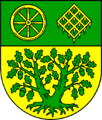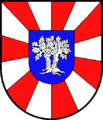Double oak

The double oak is an oak with two trunks, which sometimes have grown together in the lower part ( Zwiesel ) and form a common crown. In the course of the conflict between Danes and Germans over the status of Schleswig-Holstein under international law, it was stylized as a symbol of the togetherness of the duchies of Schleswig and Holstein .
Symbolism in the conflict over Schleswig-Holstein in the 19th century
In the 19th century, an armed conflict broke out in Schleswig-Holstein between Danish and German-minded people. In this context, the double oak became a symbol of the German insistence on the Treaty of Ripen of 1460, according to which Schleswig and Holstein were to remain " Up forever ungedeelt " (Forever undivided). As an indivisible whole, the duchies were to be incorporated into a German nation-state.
The growing together of two tribes, which form a common crown, alluded to the motto "Up forever ungedled". Just as a double oak cannot be separated without being seriously damaged and partially or completely dying, Schleswig-Holstein should only be able to exist as an undivided whole - in a (future) German nation-state.
This was countered by efforts by Danish liberals to integrate Schleswig as a Danish fiefdom with the surrender of Holstein into a future Danish nation-state. On the Danish side they found their symbols in motifs such as Mor Danmark and Sønderjyske piger .

The oak was (and is) regarded as the “German tree par excellence” because of its cultic significance for the Germans . In heraldry , it also symbolizes strength, persistence, struggle and victory.
The song "Wanke not, my fatherland", as it was presented in 1844, expresses this idea. It says in the seventh, last stanza:
- Dear country, you double oak,
- under a crown roof,
- stand firm and never give up,
- as the enemy may threaten!
- Schleswig-Holstein, relatives,
- do not waver, my country!
This song is now under the more renowned Schleswig-Holstein meerumschlungen the anthem of the federal state Schleswig-Holstein.
Symbolism in the Empire
1898 marked the fiftieth anniversary of the beginning of the first Schleswig-Holstein War , i.e. the open outbreak of hostilities in the Schleswig-Holstein conflict. On this occasion, hundreds of double oaks were planted, especially in the area of the former duchies of Schleswig and Holstein, in order to cultivate the national spirit in Schleswig-Holstein. In rural communities in particular, the double oaks proved to be an inexpensive means of representing the contemporary imperial-national ethos on the one hand and the indivisible and successfully won the German Empire on the other hand Schleswig-Holstein.
Symbolism today
While the conflict with Denmark about the borders and the affiliation of Schleswig-Holstein has long been a thing of the past, the double oak lives on as a motif typical of Schleswig-Holstein.
In Schleswig-Holstein there are still around 100 double oaks from the 19th century. Of the vast majority, however, the name that has survived in inns or the like has remained at most. Furthermore, the name lives on in clubs (e.g. TSV Doppeleiche Viöl eV from 1923). Various Schleswig-Holstein communities have the double oak in their coat of arms:
- Beldorf municipality , Rendsburg-Eckernförde district
- Community Itzstedt , Kreis Segeberg
- Jagel municipality , Schleswig-Flensburg district
- Community Looft , Steinburg
- Community Rickert , Rendsburg-Eckernförde
- also the former Hohenwestedt-Land office , Rendsburg-Eckernförde district
Sometimes the double oak is only hinted at, for example by two oak leaves in the coats of arms of the communities of Goltoft and Fleckeby , both in the Schleswig-Flensburg district. In the latter, the motif points to the merging of two parts, as symbolized by the double oak, but more contemporary on the occasion of the merger of the municipal parts Fleckeby and Götheby-Holm in 1974. The double oak in the coat of arms of the municipality of Rabenkirchen-Faulück , Schleswig district, symbolizes the same -Flensburg. On the one hand, it goes back to an actually existing double oak, but at the same time is intended to refer to the merger of Rabenkirchen and Faulück in 1971. The trunks separated at the bottom continue to grow (symbolically) since then in a common trunk with a common crown, thus varying the double oak motif.
Web links
- Schleswig-Holstein State Archives: Schleswig-Holstein's municipal coat of arms
- Meaning of the double oak in the history of Schleswig-Holstein
- Historical background at "Society for Schleswig-Holstein History"










